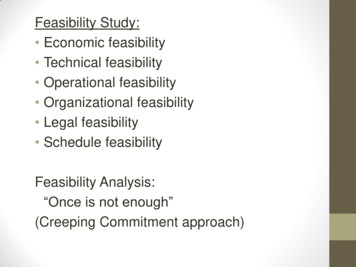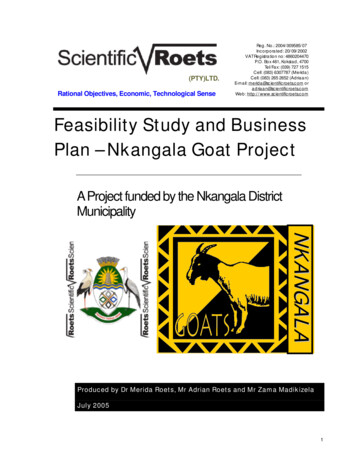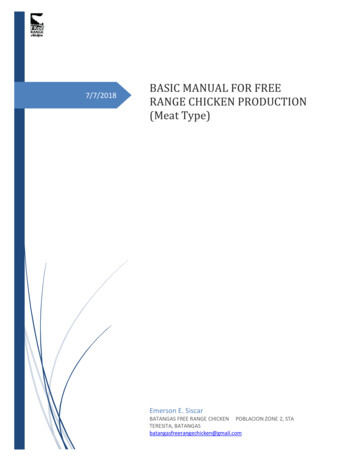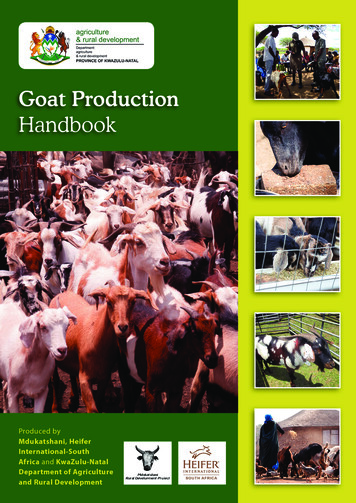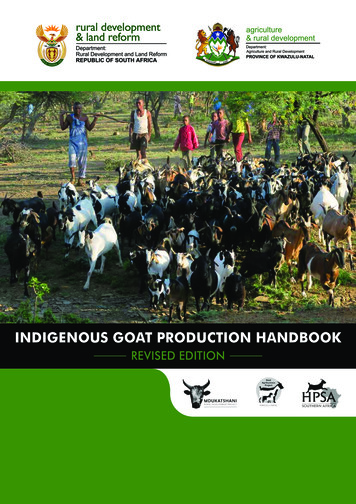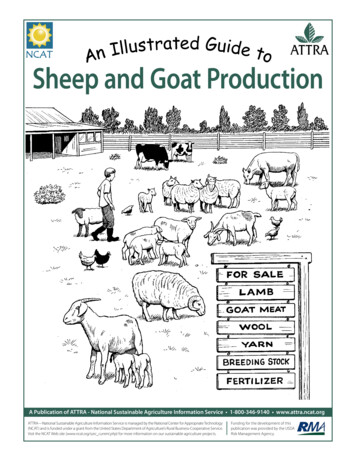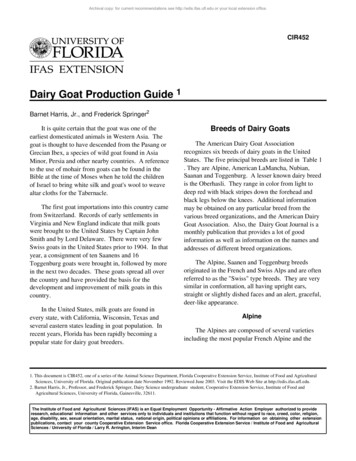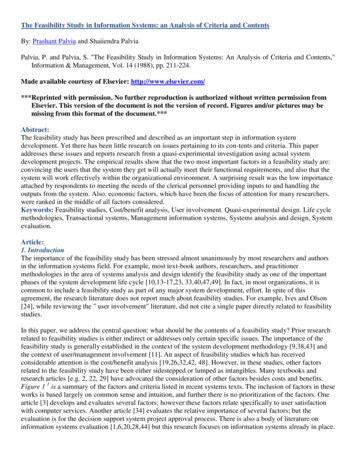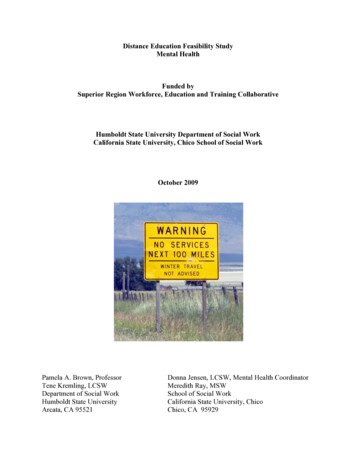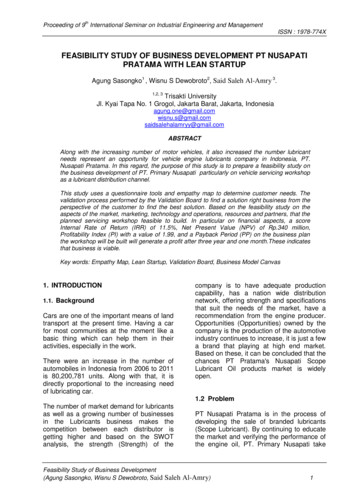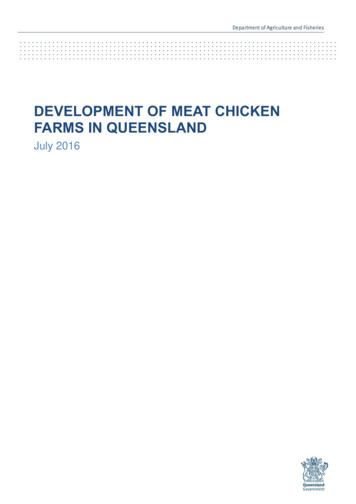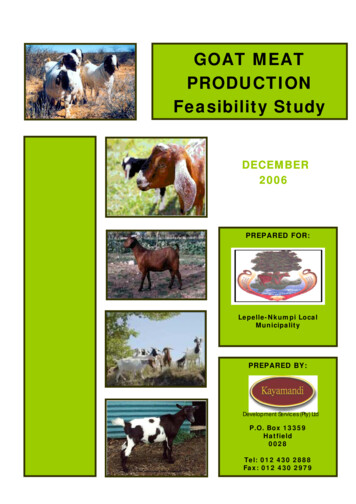
Transcription
GOAT MEATPRODUCTIONFeasibility StudyDECEMBER2006PREPARED FOR:Lepelle-Nkumpi LocalMunicipalityPREPARED BY:Development Services (Pty) LtdP.O. Box 13359Hatfield0028Tel: 012 430 2888Fax: 012 430 2979
TABLE OF CONTENTS1. INTRODUCTION . 12. DEVELOPMENT DESCRIPTION . 22.1 Background to goat farming . 22.2 Overview of goat farming process – project description. 22.3 Secondary activities . 82.4 Project location . 103. MARKET ANALYSIS . 123.1 Supply analysis . 123.2 Demand analysis . 153.3 Demand for secondary activities . 213.4 Target market. 224. RISKS, STRENGTHS & IMPACT . 244.1 Weaknesses and threats. 244.2 Strengths. 244.3 Potential impact . 255. MANAGEMENT TEAM. 285.1 Ownership and management . 285.2 Organisational structure . 306. FINANCIAL PLAN. 336.1 Goat Herd . 336.2 Operational income and expenditure . 337. IMPLEMENTATION PLAN. 367.1 Training and support . 367.2 Potential funding sources. 387.3 Actions necessary to start implementation. 39Bibliography
Goat farming feasibility1. INTRODUCTIONThe agricultural sector of Lepelle-Nkumpi contributes approximately 2% to the overallGDP generated by the municipality, constituting a slightly larger proportion of theeconomy on a local level than for the District as a whole. The agricultural sector ishowever, a far large employer in the municipality, taking up almost 6% of the overallemployment in the Municipality.However, statistics and studies hide the importance of remittances and non-farmactivities for rural households and the potential contribution of agricultural (andparticularly livestock) income in providing self-driven livelihoods for the poor. TheAgricultural sector thus remains an important industry in the economy of Lepelle-Nkumpias large tracks of rural areas are mainly held for subsistence livestock farming.Within the District the overwhelming majority of livestock are goats (44%), followed bycattle (38%), pigs (10%) and sheep (9%). Nearly all of the goats in the District (98%) arecommunally farmed. Existing livestock farming in Lepelle-Nkumpi also involves goats,cattle, sheep and poultry. As in the District, the farming of animals is one of the key subcategories of agriculture in Lepelle-Nkumpi. Goat farming is the most popular form oflivestock farming in Lepelle-Nkumpi and is mostly concentrated around the Mphahlele,Zebediela and Mafefe areas.The Limpopo Provincial Growth and Development Strategy (PGDS) also makesprovision for a red and white meat cluster, which covers all major corridors in all theDistricts of the Province. The strategy seeks, through this cluster, to encourage currentand emergent poultry and livestock production, animal-feed production, and toencourage public-private partnerships and skills development among emerging farmers.The purpose of this project, in line with the PGDS, is to establish a small-scale goatfarming project in the Mphahlele area in the Lepelle-Nkumpi Local Municipality.The remainder of this feasibility is comprised of the following Sections:Development DescriptionMarket analysisRisks, strengths and impactManagement teamFinancial PlanImplementation Plan1Development Services (Pty) LtdReg No. 1999/12439/07
Goat farming feasibility2. DEVELOPMENT DESCRIPTION2.1Background to goat farmingAccording to NAMC (2005), “Indigenous goat” is the collective term used for all varietiesof South African goat breeds. Special breed names are usually given according to thegeographical area in which goats occur, or names of breeds and types are taken overfrom the nations or tribes that own them. Indigenous goats of South Africa can beclassified into speckled goats, Loskop South indigenous goats, KwaZulu-Natal goats,Nguni goats and the Delfzijl goats (Roets, 2004). However, this classification systemdoes not accommodate the thousands of indigenous goats found outside these specificlocations throughout South Africa. The Indigenous goats of South Africa vary in hornand coat type, colour, ear length and size. They are mostly of medium size.Environmental extremes are mainly responsible for the variation in size between goattypes. It is possible to find different variations in the same region and even in the sameflock. Indigenous goats have never been subjected to any selection other than survivalin nature. They have never received special care and the management practices involvebeing milked (by some cultures) and kraaled at knight. They are known to be extremelyhardy, and have survived centuries of periodic droughts and harsh temperatureextremes. They also have the reputation of being resistant to the majority of tropicaldiseases and parasites.However, an important aspect that prevents growth in the Indigenous goat industry isthat goats are mainly “kept” by farmers and its commercial value is not optimized ascould be found in a well-managed commercial farming system. The opinion in somecircles is that black farmers do not see goats as a saleable commodity. They see themas animals for financial security and only old animals are sold, which led to the badimage of goat meat.To commercialise the goat industry, farmers must see their goats as a source ofincome. In other words, black farmers must be convinced that they could make moneyfrom goats. The biggest advantage of the Indigenous goat is its resistance to diseasesand its adaptability in unfavourable grazing circumstances. Because of their small size,adaptive feeding behaviour and low management, goats are a viable option in improvingthe household cash flow of rural people and resolve the issue of food security. Apartfrom cash income, goats could also be a valuable source of milk and meat for rural poorpeople. It is also much easier for small farmers with no land or only little land to farmwith goats than with cattle, as 10 goats could be kept on the same portion of land asone cattle.2.2 Overview of goat farming process – project descriptionMost of the indigenous goats in Lepelle-Nkumpi municipality roam freely on communalland scattered throughout the municipality (see below Diagram). As such goat farmingmainly takes place on a subsistence level where a number of families produce milk and2Development Services (Pty) LtdReg No. 1999/12439/07
Goat farming feasibilitymeat from their backyards, mostly for ceremonial purposes. Due to thecommunal/subsistence nature of goat farming in Lepelle-Nkumpi, goat farming does notform part of the formal supply chain and as such does not currently generate income oremployment.The proposed project’s primary focus will be on goat farming for meat productionpurposes in order to provide a constant supply of goats which can be supplied to nearbyabattoirs (such as Putukwane in Aganang Municipality). Given sufficient and criticalmass of goats, the project can be expanded into the development of a local abattoir(meat production), the development of hide production into finished products and thesale of excess milk and production of goat milk products.The goat farming process (for meat production), envisioned as part of this study, iscomprised of the following components (as described hereunder):Breeding programKidding phaseSelection processDiagnostics and veterinary activitiesFeeding programHousing of goatsMarketingSTEP 1: GOAT BREEDING PROGRAMGoats give birth at the beginning of the rainy season when food supply is good andmothers are able to provide plenty of milk for their offspring. One male can serve 30 to40 females. The service should take place when you can tell the female is on heat – shewill show signs of restlessness and will bleat and wag her tail. The heat cycle lasts 18 to21 days and the rest period is 24 to 36 hours.The expectant mother needs extra feed three to four weeks before kidding. Thestandard and traits (fertility, growth and longevity, etc.) are determined by the breedingstrategy. There are various kinds of breeding, such as in breeding, line breeding, andcross breeding. The definitions of these are as follows:In breeding: Inbreeding can be randomly described as the mating of first-degreerelatives (offspring and parents, or siblings).Line breeding: can be considered as the mating of related animals, but of lessclose relationship than first degree.Crossbreeding: is a philosophic and biological opposite to line breeding, andinvolves the mating of animals of two different breeds.Each of the above mentioned are going to have different consequences for the herd,and wise producers will pick a strategy that fits their own philosophies and goals. Nosingle strategy fits all situations, but each strategy is a wise choice for certain goals andproduction systems.As previously mentioned each breeding strategy produces different results, which aretabulated as follows:3Development Services (Pty) LtdReg No. 1999/12439/07
Goat farming feasibilityTable 2.1: Comparisons of inbreeding/line breeding and out breedingTraitInbreeding/line breedingOut breedingGoodPoorUniformityPoor (to good with selection)GoodFertilityPoor (to good with selection)GoodGrowthGoodPoorPredictabilityPoor (to good with selection)GoodOverall vigorModerateGoodLongevityThe above Table shows the advantages of each breeding strategy. Each strategy will beadvantageous according to every project goal. The goal of this project is to producedesirable meat goats and reproductive goats that will be utilised as replacement goats.The ideal meat goat producing system would be some sort of small, fertile, line femalethat could be mated to a large, meaty paternal line. All of the kids should be reasonablyuniform, making an appealing lot for sale. While they may not in their own turn produceuniform offspring, they themselves are uniform and the clever breeder can takeadvantage of that.STEP 2: KIDDING PHASEThis is the birth of young goats (or Kids). It takes 5 months for a goat to give birth after ithas been served by a male. The general gestation time for goats is between 149 and155 days. Does with multiple kids seem to kid earlier in the 149-155 day period, whiledoes with fewer kids will be kidding later in the period. A doe generally needs to be atleast 141 days into the pregnancy for the kids to have a decent chance of surviving.Does usually have between 1 and 2 kids, twice a year.Pregnant does need to continue as much normal activity as possible. They need thestrength to carry the extra weight during the last two months and go through the laboursuccessfully. A doe should not come into pregnancy, or the first two months, too fat.The normal activity of walking around grazing should continue.Nutrition is very important in the last two months of pregnancy. Approximately 70% ofthe weight of the kid(s) is developed from around day 100 to the birthing date. Undernourishment during this period will result in the birth of smaller kids, increased mortalityand slower growth rates. Therefore the quality of feed must be increased. High qualityhay should be fed during this period. Goats that eat a lot of hay during pregnancymaintain that ability to ingest increased levels of roughage during lactation.An appropriate type of shelter needs to be available for does to get out of the weather.This shelter could be from heat, rain, cold, etc. Once the signs of a doe getting close tolabour appear, she needs to be isolated into a small pasture or pen area. The isolatedarea may have several does close to labour. The creation of small camps with sufficientfood, shelter and shade, which are specially kept aside for the kidding season, isshowing signs of becoming the accep
The goat farming process (for meat production), envisioned as part of this study, is comprised of the following components (as described hereunder): - Breeding program - Kidding phase - Selection process - Diagnostics and veterinary activities - Feeding program - Housing of goats - Marketing STEP 1: GOAT BREEDING PROGRAM Goats give birth at the beginning of the rainy season when food supply is .
